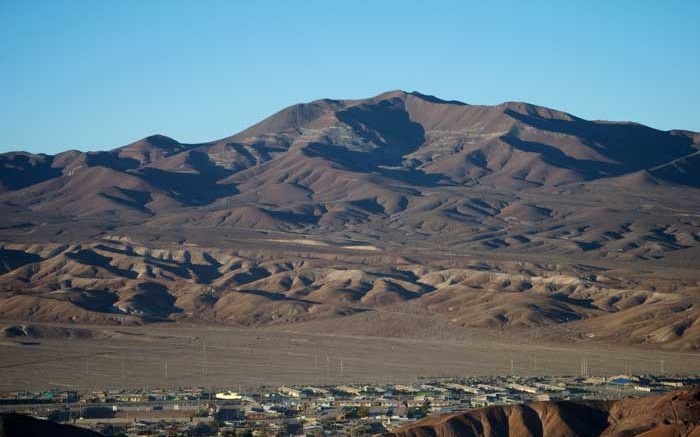When Capstone Mining’s (CS-T) Santo Domingo iron oxide-copper-gold project in Chile eventually enters commercial production in 2017 or 2018 — at an estimated capital cost of between US$1.5 billion and US$1.8 billion — the open-pit operation is expected to average annual production of 144 million lb. copper, 4.1 million tonnes of iron concentrate and 15,000 oz. gold over an 18-year mine life.
Korea Resources Corp. (KORES) owns 30% of Santo Domingo and is committed to securing up to 65% — or US$1.3 billion of the capital cost — which includes building a port and pipeline. As part of its strategic partnership, KORES will receive 50% of the copper concentrate and the same percent of its iron concentrate in off-take agreements at market prices.
A pipeline will be built to bring sea water from the coast — which is 74 km west of the project — and both copper and iron concentrate will be transported to the port via a slurry pipeline. The concentrates will then be washed, dewatered and loaded onto ships for transport to third-party smelters.
Capstone has chosen a greenfield port location about 110 km from the project site. The site was chosen, the company says, “because of its exceptionally high availability for loading iron vessels,” and Capstone submitted a formal application for the marine concession in March 2013.
A preliminary feasibility study completed in August 2011 envisioned a processing plant with average annual throughput of 63,500 tonnes per day using a semi-autogenous grinding mill and ball mill (70,000 tonnes per day in the first five years), and conventional flotation using sea water to produce a copper concentrate. (Magnetite iron will be recovered from the rough copper tailings using low-intensity magnetic separation.)
The company anticipates mining higher copper grades in the first five years of the mine life, with progressively lower copper grades and higher iron grades in the final 13 years.
Capstone expects to complete a bankable feasibility study on the project — 50 km west of Codelco’s El Salvador copper mine and 130 km north of Copiapo in Chile’s Region III — by year-end, or in the first quarter of 2014.
One of the biggest difficulties appears to be sourcing power rates that are economic. Capstone had intended to complete the bankable feasibility study in the first quarter of 2013, but “power remains a significant challenge,” Christopher Chang of Laurentian Bank Securities noted in a report on May 28, which marked the initiation of his coverage of the company.
“At this time economic rates for power are not expected to be available until 2017–2018,” Chang writes. “The company remains in discussions with several suppliers around the potential to enter into a long-term power purchase contract. Discussions could begin in the second half of 2013, with an expected contract by year-end, or early 2014.”
Capstone has also conducted several trade-off studies and project-optimization tests to trim capital and operating costs and is advancing preparations for the environmental impact study (EIS). “While the company expects to complete the required work on time, the actual filing of the EIS will likely occur at year-end to coincide with the new feasibility study timeline and to incorporate the project improvements resulting from the trade-off studies,” Chang says.
The project is made up of three deposits: Santo Domingo Sur, Iris and Iris Norte. Measured and indicated resources total 486 million tonnes grading 0.32% copper, 0.04 gram gold per tonne and 27.2% iron, for 3.4 billion contained lb. copper, 672,000 oz. gold and 132 million tonnes of iron. Chang forecasts Santo Domingo will likely enter commercial production in the second quarter of 2018 — a delay from the company’s official estimate of 2017 — and sees average life-of-mine operating cash costs, due to significant by-product production, of US10¢ per lb. copper based on US$2.75 per lb. copper, US$80 per tonne iron and US$1,100 per oz. gold.
In addition to the Santo Domingo project, the mid-tier base metal producer owns 100% of the Cozamin copper-zinc-lead-silver operation in Mexico and the Minto copper-gold-silver mine in the Yukon. It also recently acquired the Pinto Valley copper-molybdenum mine in Arizona and is advancing its wholly owned Kutcho copper-zinc-gold-silver project in B.C.
Chang has a one-year target price on Capstone of $3.50 per share, which at press time was trading at $2.25 per share within a 52-week trading range of $1.84 to $2.91. The company has 379 million shares outstanding.
He likes Capstone, among other reasons, because the company held $485 million in cash, or $1.28 per share, and no debt at the end of this year’s first quarter; could produce 113 million lb. copper in 2013; and is 90% levered to copper, which is his preferred commodity among base metals.
“With the Pinto Valley acquisition, we forecast copper production to markedly increase to 224 million lb. in 2014,” he adds, saying that the company “also has a deep pipeline of robust long-term growth opportunities in Santo Domingo and Kutcho.” The development of these projects, he contends, “could more than quadruple the company’s forecasted 2013 production by the end of the decade.”
He says that “with the acquisition of Equinox Minerals by Barrick Gold in 2011, Quadra FNX Mining by KGHM Polska Miedz S.A. in 2012 and Inmet Mining by First Quantum Minerals in 2013, the mid-tier base metals universe continues to shrink with limited alternative investment opportunities . . . investors are left with a relatively fractured junior producer market, or forced to look at markets exposed to higher political risk. Given Capstone’s market capitalization, forecast production volumes and low political-risk operations, we believe the company should benefit from a scarcity premium.”


Be the first to comment on "Santo Domingo feasibility expected in less than a year"